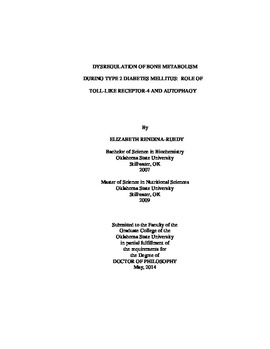| dc.contributor.advisor | Smith, Brenda J. | |
| dc.contributor.author | Rendina-Ruedy, Elizabeth | |
| dc.date.accessioned | 2015-06-17T20:07:39Z | |
| dc.date.available | 2015-06-17T20:07:39Z | |
| dc.date.issued | 2014-05 | |
| dc.identifier.uri | https://hdl.handle.net/11244/15084 | |
| dc.description.abstract | Patients with type 2 diabetes mellitus (T2DM) have demonstrated a 1.5-3.5 fold increase in fracture risk, but the mechanisms responsible remain in question. Due to the inflammatory response that has been shown to accompany T2DM and impaired insulin signaling, the purpose of this project was to: (1) determine alterations in bone metabolism and their effects on bone microarchitectural and biomechanical properties the development and progression of T2DM in a young, growing animal; (2) determine the role of toll-like receptor (TLR)-4 in this skeletal response; and (3) explore the extent to which the autophagic pathway in bone cells is altered in response to impaired insulin signaling and glucose availability. The initial study was designed to characterize long-term metabolic and skeletal response between two commonly used C57BL/6 substrains (i.e., C57BL/6 and C57BL/6N) on a high fat (HF) diet. The findings of this study show that the C57BL/6J and the C57BL/6N mouse differ in their metabolic response to a HF diet over a 24 wk study period, but their skeletal response was similar. The subsequent study demonstrated that C3H/HeJ mice with a non-functional TLR-4, were somewhat protected from the metabolic changes induced by a HF diet and were also protected from the deleterious impact a HF diet exerted on bone. The final study demonstrated that autophagy was up-regulated in bone and as impaired glucose tolerance progressed, autophagic flux was enhanced as evidenced by the increased pBeclin1 protein expression. Furthermore, the development and progression of impaired glucose tolerance was associated with osteoblast maturation and an apparent increase in osteocytes. The ability of autophagy to drive osteoblast maturation was further confirmed by the ability of rapamycin-mediated autophagy to shift the phenotype of MC3T3-E1 towards that of a more mature osteoblast. Therefore, the results from these studies (1) establish an appropriate mouse model for the pathogenesis of T2DM; (2) suggest that the metabolic changes associated with a HF diet attenuate bone accrual by altering bone turnover, and that TLR-4 is involved in this skeletal phenotype; and (3) Beclin1-mediated autophagy appears to be up-regulated during impaired glucose tolerance, driving the osteoblast towards a more mature, non-mineralizing phenotype. | |
| dc.format | application/pdf | |
| dc.language | en_US | |
| dc.rights | Copyright is held by the author who has granted the Oklahoma State University Library the non-exclusive right to share this material in its institutional repository. Contact Digital Library Services at lib-dls@okstate.edu or 405-744-9161 for the permission policy on the use, reproduction or distribution of this material. | |
| dc.title | Dysregulation of bone metabolism during type 2 diabetes mellitus: Role of toll-like receptor-4 and autophagy | |
| dc.contributor.committeeMember | Clarke, Stephen L. | |
| dc.contributor.committeeMember | Lucas, Edralin A. | |
| dc.contributor.committeeMember | Stoecker, Barbara J. | |
| dc.contributor.committeeMember | Miller, Rita K. | |
| osu.filename | RendinaRuedy_okstate_0664D_13393.pdf | |
| osu.accesstype | Open Access | |
| dc.type.genre | Dissertation | |
| dc.type.material | Text | |
| dc.subject.keywords | osteoblast | |
| dc.subject.keywords | osteoclast | |
| dc.subject.keywords | osteocyte | |
| thesis.degree.discipline | Human Sciences | |
| thesis.degree.grantor | Oklahoma State University | |
